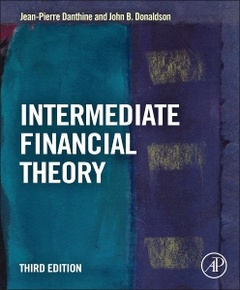Description
Intermediate Financial Theory (3rd Ed.)
Authors: Danthine Jean-Pierre, Donaldson John B.
Language: English
Subjects for Intermediate Financial Theory:
Keywords
Allais paradox; Arbitrage Pricing Theory; Arbitrage pricing theory; Arrow-Debreu; Arrow-Debreu (AD) pricing; Arrow-Debreu model; Arrow-Debreu prices; Arrow-Debreu pricing theory; Arrow-Debreu securities; Arrow-Debreu setting; Arrow-Pratt measure; BE/ME ratio; Black-Scholes formula; Brownian motion; CAPM; CCAPM; CRRA; Canonical portfolio problem; Capital asset pricing model; Capital market line; Cash flow; Certainty equivalent; Closed-form pricing; Competitive equilibrium; Complex securities; Constant absolute risk aversion (CARA); Continuous time processes; Cross-correlations; Declining absolute risk aversion (DARA); Dybvig's evaluation; Economic rationality; Edgeworth-Bowley box; FOCs; Great Moderation; Great Recession; Great Recession case; Hansen-Jagannathan bounds; Jensen's inequality; Joint saving-portfolio problem; Lucas tree; MPT; Market model; Mean-variance space; Modern portfolio theory; Modigliani-Miller Theorem; Modigliani-Miller theorem; No-trade equilibrium; Nonnegativity constraints; Normality-of-returns; Optimal portfolio; Pareto optimal; Payoff; Positive correlation; Posttrade allocation; Present value (PV); Prospect Theory; Random variable; Random walks; Rational expectations equilibrium; Rational expectations hypothesis; Risk aversion; Risk sharing; Risk-free rate; Risk-neutral probabilities; Risk-neutral valuation; Sawtooth pattern; Sharpe ratio; State-by-state dominance; State-contingent claim; T-bill rate; VNM; Value Additivity Theorem; Walrasian equilibrium; Wiener process; Zero-beta CAPM
Approximative price 98.24 €
In Print (Delivery period: 14 days).
Add to cart580 p. · 19x23.3 cm · Hardback
Description
/li>Contents
/li>Readership
/li>Biography
/li>Comment
/li>
Targeting readers with backgrounds in economics, Intermediate Financial Theory, Third Edition includes new material on the asset pricing implications of behavioral finance perspectives, recent developments in portfolio choice, derivatives-risk neutral pricing research, and implications of the 2008 financial crisis. Each chapter concludes with questions, and for the first time a freely accessible website presents complementary and supplementary material for every chapter. Known for its rigor and intuition, Intermediate Financial Theory is perfect for those who need basic training in financial theory and those looking for a user-friendly introduction to advanced theory.
1. Role of Financial Markets2. Challenges of Asset PricingII.3. Choices in Risky Situations4. Measuring Risk and Risk Aversion5. Risk Aversion and Investment Decisions, Part 16. Risk Aversion and Investment Decisions, Part 27. Risk Aversion and Investment Decisions, Part 3III.8. The CAPM9. Arrow-Debreu Pricing, Part I10. The Consumption Capital Asset Pricing Model (CCAPM)11. Arrow Debreu Pricing, Part IIIV.12. The Martingale Measure in Discrete Time, Part 113. The Martingale Measure in Discrete Time, Part 214. The APT15. Continuous Time Finance16. Portfolio Management in the Long Run17. Financial Structure and Firm Valuation in Incomplete MarketsV.18. Financial Equilibrium with Differential Information
He is an Associate Editor of Macroeconomic Dynamics and Finance Research Letters; Chairman of the Scientific Council of the TCIP (Training Center for Investment Professionals); member of the Council of the European Economic Association, of the Scientific Councils of CEPREMAP (Paris), CREST (Paris), CREI (U. Pompeu Fabra, Barcelona) as well as the Fonds national de la recherche scientifique (Economics Commission - Belgium). He was also a member of the Executive Committee of the ICMB (Geneva).
Professor Donaldson holds the teaches the Mario J. Gabelli Professorship in Finance at Columbia Business school, teaching courses in basic finance and options. He focuses on business cycles and asset pricing, with a particular emphasis on the real side of the economy’s impact on equilibrium pricing of financial assets. His work has appeared in numerous professional journals, including the Journal of Economic Dynamics and Control, Econometrica, the Journal of Economic Theory and the Journal of Monetary Economics.
- Completely updated edition of classic textbook that fills a gap between MBA- and PhD-level texts
- Focuses on clear explanations of key concepts and requires limited mathematical prerequisites
- Online solutions manual available
- Updates include new structure emphasizing the distinction between the equilibrium and the arbitrage perspectives on valuation and pricing, and a new chapter on asset management for the long-term investor
These books may interest you

Financial Asset Pricing Theory 67.55 €

Handbook of Market Risk 169.38 €


